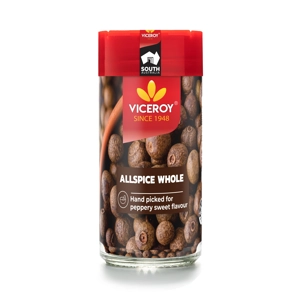
Allspice Whole
Allspice, scientifically known as Pimenta dioica, is a versatile spice that originates from the unripe berries of an evergreen tree native to the Caribbean, Central America, and parts of Mexico. This spice earned its name from its unique flavor, which combines the tastes of cinnamon, cloves, nutmeg, and pepper, giving it a warm and complex profile. While ground allspice is commonly found in grocery stores, using whole allspice berries provides a fresher and more robust flavor. In this exploration of allspice whole, we will delve into its history, culinary uses, health benefits, and some creative ways to incorporate it into your kitchen.
History and Origin:
Allspice has a rich history dating back to the indigenous people of the Caribbean and Central America, who were the first to discover its aromatic and flavorful properties. The native Taino people used allspice in various aspects of their lives, including cooking, medicine, and even spiritual rituals. When Christopher Columbus arrived in the Americas, he encountered this unique spice and brought it back to Europe, where it gained popularity for its resemblance to a combination of other spices.
The name "allspice" was coined in the 17th century, reflecting the belief that it captured the essence of several different spices. Despite its widespread use in Europe, allspice primarily thrives in the warm and humid climates of the Caribbean, making it a significant part of the region's culinary tradition.
Botanical Characteristics:
The allspice tree, also known as the Pimenta tree, is an evergreen that belongs to the Myrtaceae family. It can grow up to 30 feet in height and produces small, greenish-white flowers, which eventually develop into the berries we know as allspice. The berries resemble peppercorns and are harvested when they are still green but fully mature. Once picked, the berries are dried in the sun, turning them a reddish-brown color and intensifying their flavor.
Culinary Uses:
Allspice is a staple in many kitchens around the world, celebrated for its ability to add depth and warmth to both sweet and savory dishes. When using whole allspice, the berries are typically added to dishes during cooking, allowing their flavors to infuse into the food. Here are some popular culinary uses of allspice whole:
-
Pickling and Brining: Whole allspice berries are often included in pickling spice blends, enhancing the flavor of pickles, beets, and other preserved vegetables. They contribute a unique and aromatic note to the brine.
-
Baking: Allspice is a key ingredient in many baked goods, such as cakes, cookies, and pies. Whole allspice can be ground before use or added directly to the dish for a burst of flavor.
-
Stews and Soups: Allspice berries are a common addition to hearty stews, soups, and curries. They complement the savory flavors and add warmth to the overall taste.
-
Mulled Beverages: Allspice is a popular choice for mulled beverages, including cider and wine. Whole berries are added to the mixture, infusing it with a delightful blend of spices.
-
Marinades: Whole allspice berries are excellent in marinades for meats, particularly for grilling or roasting. The berries release their flavors slowly, imparting a subtle spiciness to the meat.
Health Benefits:
Beyond its culinary uses, allspice also offers various health benefits:
-
Antioxidant Properties: Allspice contains compounds with antioxidant properties, which help combat oxidative stress and inflammation in the body.
-
Digestive Aid: Allspice has been traditionally used to aid digestion. It may help alleviate indigestion, bloating, and gas.
-
Anti-Inflammatory: The compounds found in allspice have anti-inflammatory effects, potentially benefiting conditions related to inflammation.
-
Pain Relief: Allspice has analgesic properties, and its oil has been used topically for relieving pain, especially in traditional medicine.
-
Rich in Nutrients: Allspice contains essential nutrients such as vitamins A and C, as well as minerals like potassium, manganese, and iron.
Creative Uses:
Expand your culinary horizons by exploring these creative uses of whole allspice:
-
Infused Beverages: Create your own allspice-infused beverages by adding whole berries to teas, cocktails, or even water. The subtle spiciness adds a unique twist to your favorite drinks.
-
Potpourri and Sachets: Combine whole allspice berries with other aromatic ingredients to create potpourri or sachets. Place them in closets or drawers for a natural and pleasant fragrance.
-
Homemade Extracts: Make your own allspice extract by steeping whole berries in alcohol. This DIY extract can be used in baking or to enhance the flavor of beverages.
-
Spiced Oils and Vinegars: Infuse oils or vinegars with whole allspice for a versatile and flavorful base for dressings, marinades, or dipping sauces.
-
Grinding Spices on Demand: Invest in a high-quality spice grinder and grind whole allspice berries as needed. This ensures maximum flavor and aroma in your dishes.
Storage Tips:
To preserve the freshness and flavor of whole allspice berries, follow these storage tips:
-
Airtight Container: Store whole allspice in an airtight container away from heat, light, and moisture.
-
Cool, Dark Place: Keep the container in a cool, dark place, such as a pantry. Avoid storing it near the stove or in direct sunlight.
-
Avoid Grinding in Advance: If possible, grind the allspice berries just before use to retain their essential oils and flavor.
In Conclusion:
Allspice whole, with its rich history, versatile culinary applications, and potential health benefits, is a remarkable spice that deserves a place in every kitchen. Whether you use it in baking, pickling, or as a creative infusion, whole allspice berries contribute a distinctive warmth and complexity to your dishes. Experiment with this spice to elevate your culinary creations and explore the vast world of flavors that allspice has to offer.

